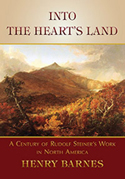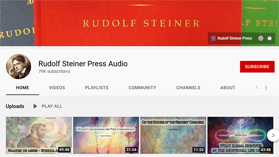
-
INTO THE HEART'S LAND
A Century of Rudolf Steiner's Work in North America
Henry Barnes

Henry Barnes—the author of A Life for the Spirit—brings us a comprehensive view of the development of the anthroposophic movement in North America. During its initial phase in the early 1900s, Americans began to return from Europe with word of an individual who spoke about the spiritual world from direct experience. The first spritual-scientific initiatives began in New York in the 1930s and spread across the prairies to the West Coast and beyond—to Canada, Mexico, and Hawaii—taking root in the hearts and minds of the “new world.”
This is the story of those adventurous spirits who took responsibility for bringing the work of Rudolf Steiner to North America—in the form of study groups, lecture tours, a library, publishing ventures, artistic renewal, anthroposophically extended medicine, biodynamic agriculture, threefold social initiatives, Waldorf schools, The Christian Community, Camphill villages, and more.
In broad sweeps and intimate details, Into the Heart’s Land covers—in three, thirty-three-year phases—the movement’s first impulse and building the foundations (1900–1933); making roots (1933–1967); and new growth and bearing fruit (1967–2000).
The last part of the book takes up enduring themes at the heart of the anthroposophic movement, current initiatives, and, finally, includes a section on looking toward the future of Anthroposophy in North America.
Throughout this volume, these questions always hover: How has Anthroposophy fared in the New World? To what extent has it recognized the reality of the spirit and the essential role of a truly free and independent spiritual and cultural life?
From the Introduction
The history of Anthroposophy in America can be truly understood only in the context of recent history. And, within this wider context, what we have come to know as World War I (1914–1918) played a decisive role. That conflict set the stage for the twentieth century, and it remains with us today. As we shall learn in chapter four, it was during these years that Rudolf Steiner achieved final clarity in his years of research into the threefold nature of the human being. It was also during this time that the Goetheanum was rising in the northwest corner of Switzerland, within sound of the French and German guns dueling along the Rhine. This building, intended to be a home for Anthroposophy and as a center for the renewal of modern culture, was burned to the ground during the night of New Year’s Eve at the end of 1922. The war had ended in November 1918. One year later, the Waldorf School in Stuttgart, Germany, opened its doors and soon grew to be the largest independent private school in Germany, only to be closed by the Hitler government in 1938.
In December 1919, for the first time after the war, two parties of English friends found their way to Dornach, and Rudolf Steiner was moved to give lectures for both groups: four lectures in December 1919, and three in February 1920.* In both series Steiner spoke with great earnestness about the responsibilities that then devolved on the Anglo-American peoples, the victors in the war.
The theme that resounded through all seven lectures was the urgent need to recognize that, unless the three spheres of society were clearly distinguished, one could not hope to heal the social illness that led to the war. And, before this could happen, society would first have to recognize the need to create a sphere of cultural spiritual freedom, totally independent of political and economic control. Only through the renewal of spiritual life could one hope for real progress in human affairs. Rudolf Steiner warmly welcomed the English visitors and minced no words in describing the responsibility that now rested on the shoulders of the Anglo-American world. In the third lecture, for example, on December 14, he said:
"Well, the actual victor is the being of the Anglo-American peoples, and, as a result of forces that I have often described here, this being of the Anglo-American peoples is destined to dominate the world in the future.... The transfer of external dominion will take place with the relentlessness of a force of nature.... Already inscribed in the book of human destiny is the question: Will there be a sufficient number among those impelled to assume external dominion, as though by a force from outside, who feel a responsibility for inserting into this entirely external, materialistic dominion—for that is what it will be, make no mistake—an impetus for spiritual life?"October 2016; SB; 686pp; 25.5 x 18mm; pb;
£35.00 ISBN 9781621480341

